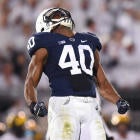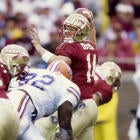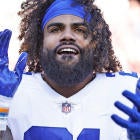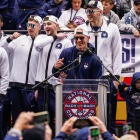Teams can't always land the prospects they covet the most in the NFL draft. And in one of the more-hyped classes of the past 20 years -- mainly due to the quarterbacks -- there will be a high rate of contingency plans being used on the second and third days of the draft in late April.
This article will identify "lite" versions of top prospects who likely won't cost an early-round selection.
Quarterback
Plan A: Josh Rosen, UCLA
Rosen was utilized under center more than any of the top quarterback prospects in this draft, which should be appealing to some of the more old-school offensive coordinators in football. His ball-handling on play-action fakes is fundamentally sound, and he's very accurate at the intermediate levels.
Plan B: Nick Stevens, Colorado State
At Colorado State, Stevens got loads of experience operating under center, and the system he ran in college was rooted in many classic pro-style elements. There are flashes of impressive accuracy in the 10-19 yard range too, although his ball placement isn't nearly as impressive as Rosen's.
Running Back
Plan A: Saquon Barkley, Penn State
Barkley is eerily similar to Ezekiel Elliott as a prospect. He's more explosive and a better receiver than Elliott was when he entered the league out of Ohio State in 2015. Elliott was the better pass-protector and was more efficient between the tackles. Barkley's ridiculous flexibility to make jaw-dropping cuts and athleticism to quickly accelerate after jukes are what separate him from the other backs in this class.
Plan B: Ito Smith, Southern Miss
Smith is the runner with comparable film and overall skills to Barkley who won't likely be picked on either of the first two days of the draft. His jump cut covers a lot of ground and is arguably more effective than Barkley's when it comes to eluding a linebacker in the hole or cutting through a backside lane. He's also comfortable as a receiver, as he caught at least 40 passes in his final three seasons at Southern Miss and averaged a hefty 10.3 yards per grab in that span. There's some downfield juice to his game once he hits daylight as well.
Wide Receiver
Plan A: D.J. Moore, Maryland
After a combine performance that quantified the spring-loaded athleticism he showcased on tape, Moore is a wideout who could sneak into the back end of the first round. He's a yards-after-the-catch monster who also flashed plus high-pointing ability despite not having a large, 6-foot-3 frame.
Plan B: Korey Robertson, Southern Miss
At nearly the same size as Moore -- 6-0, 212 pounds -- Robertson has a similar game, though he's not as speedy down the field. Then again, Moore wasn't a downfield burner at Maryland despite his 4.42 speed. Robertson has deceptive wiggle, is balanced, can absorb hits and stay on his feet after the catch. His film also features a handful of impressive grabs in contested-catch situations. Likely a Day Three selection, Robertson will represent fantastic value.
Tight End
Plan A: Dallas Goedert, South Dakota State
Goedert has the finest combination of blocking ability, strong hands, and yards-after-the-catch skills of any tight end in this class. Yes, it may take him some time to acclimate to the speed of the professional game, but he has the size at almost 6-5 and 256 pounds to be a difficult matchup for any defender at the next level. He'll probably be picked in the second round, and if it weren't for some injuries during the pre-draft process, he would've had a decent chance to jump into Round 1.
Plan B: Durham Smythe, Notre Dame
Smythe's resume as a receiver can't stack up to Goedert's. He might be a better blocker though. The Notre Dame tight end was essentially a glorified offensive tackle for a sizable portion of his career in South Bend, and he flashed as a pass-catcher late for the Fighting Irish. Smythe won't provide the seam-threatening capabilities of Goedert. He's a similarly sized, hard-nosed blocker who can win in the red zone, and he likely won't be picked until the third or fourth round.
Offensive Tackle
Plan A: Mike McGlinchey, Notre Dame
McGlinchey has a good shot to be the first offensive tackle taken in the 2018 draft, and it'd be shocking if he wasn't one of the first two picked. He probably would've gone in Round 1 or Round 2 a year ago and certainly didn't have a disappointing senior campaign at Notre Dame. He's a skilled pass-protector who has some troubles against speed-rushers or those with plenty of power. In the run-game, he moves surprisingly well to the second level relative to his size.
Plan B: Will Richardson, NC State
Richardson is a brick-wall pass-protector who's nearly 6-6 with long, powerful arms, a noticeable mean streak, and impressive athleticism. Like McGlinchey, he could stand to add some weight to help in anchoring situations against bull rushes, but that's nit-picking. Richardson is steady in pass-protection due to his length and constantly moving feet. He's also more than capable on reach blocks and when he needs to block linebackers beyond the line of scrimmage. The former NC State standout will likely be picked in one of the middle rounds and has the complete skill-set to start as a rookie.
Offensive Guard
Plan A: Quenton Nelson, Notre Dame
Nelson is a ultra-physical, punishing guard prospect with good feet and loads of experience. On occasion he's beaten by a counter move. Much more often than not, he resets wonderfully and battles through the whistle. You want him leading the way on the frontside of run plays.
Plan B: Austin Corbett, Nevada
Though Corbett played tackle at Nevada, he looks ready to be man a guard spot in the NFL. He delivers a devastating punch and continues to use his powerful hands to his advantage throughout the play. He's mobile enough in a straight line to kick inside to guard, too, and probably isn't quick enough to deal with fast speed-rushers on the edge. For teams that missed on Nelson but are in the market for an offensive lineman with a nasty demeanor and the strength to back it up, Corbett is the one to target in the second or third round.
Center
Plan A: Billy Price, Ohio State
Price is one of the most experienced players in the entire draft, and he can play center or guard at the next level. He's an old-school battler who'll maul in the run-game and has had many high-quality reps in pass protection.
Plan B: Will Clapp, LSU
I feel similarly about Clapp as I do about Price. The former LSU star is an SEC-tested pivot who's the less-athletic version of Price, and he frequently gets the job done in the run game or when blocking on pass plays. Like Price, Clapp played guard in 2016 then moved to center for his final collegiate campaign and thrived. Don't be surprised when he's picked in one of the late rounds and ultimately carves out a nice career in the NFL.
Edge-Rusher
Plan A: Bradley Chubb, NC State
Chubb is the consensus premier edge-rusher in this class. He wins with strength, speed, bend, and hand-usage. Outside of being a freak athlete like Myles Garrett proved to be at the 2017 combine -- and Chubb's combine wasn't bad -- the nearly 6-5, 269-pound former NC State star checks all the boxes.
Plan B: Duke Ejiofor, Wake Forest
An injury kept Ejiofor from participating at the combine. On the field, he's one of the most NFL-ready edge-rushers in this class. While not an electric speed-rusher, Ejiofor has active, powerful hands and deploys them frequently when rushing the passer. He also uses those hands to stack and shed blocks in the run-game often. Ejiofor has a noticeably well-rounded game, and likely will hear his name called in one of the middle rounds ... maybe on Day 2.
Defensive Tackle
Plan A: Vita Vea, Washington
Vea is a first-round lock at the defensive tackle position. Blessed with nose-tackle size and scary athleticism, Vea gradually became a quality pass-rusher at Washington and has NFL veteran strength to toss offensive linemen aside. He's extremely difficult to move -- even when double teams are utilized.
Plan B: Foley Fatukasi, UConn
Another nose tackle at heart, Fatukasi is immensely strong and utilizes his lead-pipe arms to wreck run plays often. He's not as dynamic of an athlete as Vea is, but he'll likely be available in the third or fourth round and can provide most of what Vea can at much better value.
Linebacker
Plan A: Rashaan Evans, Alabama
Evans is an experienced, hard-hitting middle linebacker who may take an extra split second to recognize the play design but will get to the football in a hurry, especially coming downhill. He doesn't lack in the aggression department and has moderately good speed to the sidelines and in coverage.
Plan B: Jason Cabinda, Penn State
Cabinda is essentially the same player as Evans, and he's likely to be on the board on Day 3. He amassed 268 tackles, 17 tackles for loss and seven sacks in his last three seasons at Penn State. From his middle-linebacker spot, Cabinda was a menace against the run, rarely allowing blocks to move him backward. In fact, he jolted offensive linemen with his pop and often shed blockers to make plays on the football. His movements are more jagged than fluid, and he was effective in coverage because he never stopped moving and quickly reacted to the eyes of opposing quarterbacks. Cabinda is one of my favorite sleepers in this class.
Cornerback
Plan A: Denzel Ward, Ohio State
Ward has a smaller frame than most early first-round cornerbacks. That's the only major ding on his game. He has 4.32 speed and smooth athleticism to stay with the more gifted wide receivers and typically gets his head around to make plays on the ball down the field.
Plan B: Parry Nickerson, Tulane
Nickerson might have the best ball skills of any corner in this class. Seriously. He had the same 40-yard dash time as Ward at the combine and a similar build. While Nickerson doesn't click and close as rapidly as Ward, he's seemingly always aware of when the ball is arriving and is ultra-aggressive in his pass-breakup attempts. Nickerson will likely be available in one of the middle rounds.
Safety
Plan A: Derwin James, Florida State
Play James anywhere in the secondary and he's going to make a variety of plays. He's an impeccable blitzer with the speed and bend to get to the quarterback, and it's rare to see him miss an open-field tackle. At 6-3 and 210-plus pounds with long arms and explosive athleticism, the former Florida State star will be a true difference-maker at the next level.
Plan B: Justin Reid, Stanford
Reid isn't quite the same athlete as James, yet he's capable of handling multiple responsibilities in the secondary. There are some bad tackling whiffs and lapses in coverage on film, and he counters those plays with many displays of high football IQ, reps in which he peels off one wideout to make a play in a different zone. With plenty of experience and production in the box and at slot corner, Reid is ready for today's NFL.





















